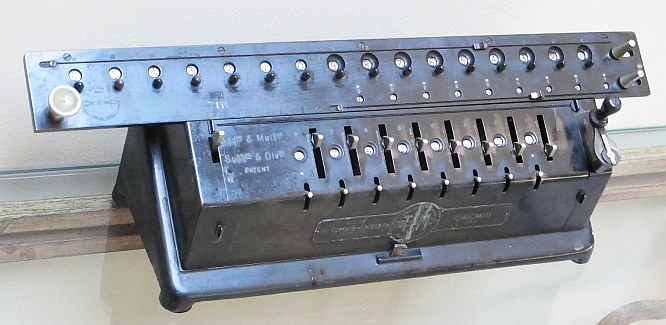previous <<==>> next
|
T.I.M. - Model III " TIME - IS - MONEY "  Have a look at the Maintenance Procedure ... Have a look at the "TRAVEL-T.I.M." ... |
TECHNICAL DATA of the Mechanical Calculator » T.I.M. « MODEL III
*************************************************************************
( = " TIME - IS - MONEY " )
Serial Number(s): Left = 8901 ; 05669 = Right ( under the carriage )
Dimensions: (ca.) Width = 21_5/8" / 55 cm
Depth = 6 " / 15 cm
Height = 6_5/8" / 17 cm
Weight: (ca.) 24 lbs / 11 kg
Mechanics: StepDrum / Staffelwalze
Functions: Add, Subtract, Multiply, Divide
Registers: Input = 8 Decimals (= Sliders )
Counter = 9 Decimals (NO Carry; Neg.Figs RED)
Arithmetic = 16 Decimals
Manufacturer:
LUDWIG SPITZ & Co.
Berlin / Tempelhof
Germany
1910
H O W T O U S E the » T.I.M. « - Model III
****************************************************
R E M : The COUNTER-FIGURES (w/r) follows the "FELIKS-TYPE"-Scheme ...
BEFORE STARTING A TASK:
-----------------------
Turn the CRANK to idle POSITION (see picture).
CLEAR the whole INPUT FIELD by pulling the MOST RIGHT LEVER on front.
( ALL COLUMNS LEFT OF the used Clear-Lever will be cleared !)
CLEAR the ARITHMETIC & COUNTER UNIT by
o LIFTING the CARRIAGE and ...
o ... PULL to the RIGHT: UPPER Handle & LOWER Handle
LIFT & SHIFT the CARRIAGE to the far left ( = POSITION 1).
ADDITION & SUBTRACTION:
-----------------------
Example: 123 + 45 - 6 = 162
ADDITION: SET the LEFT LEVER to ADD/MULT.
Enter the first number (123) in the far right columns. Make a (clockwise
only!) turn with the crank to transfer the number into arithmetic unit.
The counting unit displays the figure 1. Enter the second number (45).
Make a turn with the crank to add the number. The arithmetic unit displays
the intermediate sum (168) and the counting unit displays the figure 2.
SUBTRACTION: SET the LEFT LEVER to SUB/DIV.
Enter the third number (6). Make a turn with the crank. The arithmetic
unit displays the result (162) and the counting unit is decreased by 1.
REMARK: NEGATIVE RESULTS are displayed in the arithmetic unit
as the COMPLEMENT of the next higher 10, 100, 1000, ...
Example: -12 = 99...9988
MULTIPLICATION:
---------------
Example: 123 x 45 = 5535
CLEAR counter and arithmetic units. SET the LEFT LEVER to ADD/MULT.
Enter multiplicand (123) in the far right of the input unit. The multipli-
cator (45) has two digits, so the arithmetic unit is moved to position 2
by LIFT & SHIFT the CARRIAGE. Repeat making turns with the crank, until
the first figure of the multiplicator (4) will appear in the 2nd position
of the counter unit. Move the arithmetic unit by LIFT & SHIFT to
position 1. Repeat making turns with the crank, until the second figure
of the multiplicator (5) appears in the 1st position of the counter unit.
The multiplication is done: The multiplicand (123) stays in input unit,
the multiplicator (45) in the counter unit and the result (5535) is in
the arithmetic unit.
DIVISION:
---------
Example: 22 : 7 = 3.14285714 Remainder 2
Division requires 3 steps:
(A) To Set the Dividend into Arithmetic Unit:
-----------------------------------------
SET the LEFT LEVER to SUB/DIV.
For the maximum number of decimals, LIFT & SHIFT the arithmetic
to the far right position and ENTER the DIVIDENT (22) in columns
10 & 9 of the ARITHMETIC with the affiliated conic knobs.
(B) To Set the Divisor in the Keyboard:
-----------------------------------
CLEAR COUNTER & INPUT unit.
Enter the divisor (7) in the far right column.
(C) To Divide:
----------
Make turns with the crank until the arithmetic shows an "underflow".
SET the LEFT LEVER to ADD/MULT, make a turn with the crank. SET the
LEVER back to SUB/DIV. LIFT & SHIFT the carriage to the next left
position. Repeat this procedure until required number of decimals ...
The result (3.14285714) is in the counter unit ( in RED ), and the
remainder (2) is in the arithmetic unit. The divisor (7) stays in the
input unit, therefore an additional decimal can be estimated ...
( 2, cause 2 x 7 = 14 ... The sequence repeats !)
Have a look at "Calculating Trickies" ...
Have a look at the Maintenance Procedure ...
impressum:
***************************************************************************
© C.HAMANN http://public.BHT-Berlin.de/hamann 10/14/16
|